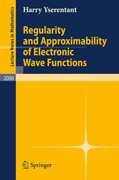
The electronic Schrödinger equation describes the motion of N-electrons underCoulomb interaction forces in a field of clamped nuclei. The solutions of this equation, the electronic wave functions, depend on 3N variables, three spatial dimensions for each electron. Approximating these solutions is thus inordinately challenging, and it is conventionally believed that a reduction to simplified models, such as those of the Hartree-Fock method or density functional theory, is the only tenable approach. The text shows that this conventional wisdom need not be ironclad: the regularity of the solutions, which increases with the number of electrons, the decay behavior of their mixed derivatives, and the antisymmetry enforced by the Pauli principle contribute properties that allow these functions to be approximated with an order of complexity which comesarbitrarily close to that for a system of one or two electrons. The text is accessible to a mathematical audience at early graduate level. The style is excellent and pedagogical The author is first class analyst Accessible to a mathematical audience at the beginning graduate level as well as to physicists and theoretical chemists with a comparable mathematical background The contents requires no deeper knowledge of the theory of partial differential equations, offunctional analysis, or quantum theory
- ISBN: 978-3-642-12247-7
- Editorial: Springer
- Encuadernacion: Rústica
- Páginas: 190
- Fecha Publicación: 01/06/2010
- Nº Volúmenes: 1
- Idioma: Inglés
